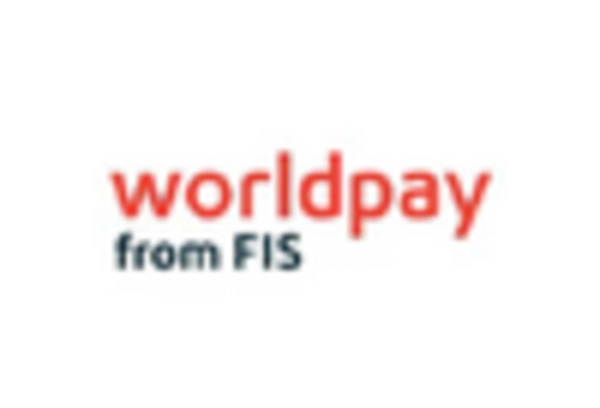Increasing E-commerce Adoption
The surge in e-commerce activities in Germany is a pivotal driver for the payment service market. As consumers increasingly prefer online shopping, the demand for efficient and secure payment solutions has escalated. In 2025, e-commerce sales in Germany are projected to reach approximately €100 billion, indicating a robust growth trajectory. This shift necessitates payment service providers to enhance their offerings, ensuring seamless transactions and improved user experiences. The payment service market must adapt to the evolving landscape. This includes integrating advanced technologies such as AI and machine learning to facilitate fraud detection and secure payment processing. Furthermore, the rise of mobile commerce is likely to further influence consumer preferences, compelling payment service providers to innovate continuously and cater to the dynamic needs of online shoppers.
Rise of Mobile Payment Solutions
The proliferation of smartphones in Germany is significantly influencing the payment service market, particularly through the rise of mobile payment solutions. As of 2025, it is projected that mobile payments will account for over 30% of all transactions, reflecting a substantial shift in consumer behavior. This trend is driven by the convenience and accessibility that mobile payment applications offer, allowing users to make transactions anytime and anywhere. Payment service providers are increasingly focusing on developing user-friendly mobile platforms that integrate various payment methods, including digital wallets and QR code payments. Furthermore, partnerships with retailers and service providers are likely to enhance the adoption of mobile payments, creating a more integrated ecosystem. The growth of mobile payment solutions is expected to reshape the competitive landscape of the payment service market, compelling traditional providers to adapt to this new reality.
Regulatory Compliance and Security
Regulatory frameworks in Germany are becoming increasingly stringent, significantly impacting the payment service market. The implementation of the Payment Services Directive 2 (PSD2) mandates enhanced security measures and transparency in payment transactions. This regulatory environment compels payment service providers to invest in robust security protocols, such as two-factor authentication and encryption technologies, to protect consumer data. As of 2025, compliance with these regulations is not merely a legal obligation but also a competitive advantage, as consumers prioritize security in their payment choices. The payment service market must navigate these complexities while ensuring that their solutions remain user-friendly and accessible. Consequently, the focus on regulatory compliance is likely to drive innovation and investment in secure payment technologies, shaping the future landscape of the industry.
Consumer Preference for Seamless Transactions
Consumer behavior in Germany is evolving, with a marked preference for seamless and frictionless payment experiences. The payment service market is responding to this trend by developing solutions that minimize transaction times and enhance convenience. As of 2025, studies indicate that nearly 70% of consumers favor payment methods that offer instant processing and minimal steps. This shift is prompting payment service providers to streamline their processes, integrating features such as one-click payments and automated billing. Additionally, the rise of subscription-based services is likely to further influence consumer expectations, necessitating payment solutions that can accommodate recurring transactions effortlessly. The focus on creating a seamless payment experience is expected to drive competition among providers, ultimately benefiting consumers through improved service offerings.
Technological Advancements in Payment Solutions
Technological innovation is a fundamental driver of the payment service market in Germany. The rapid evolution of payment technologies, including blockchain, artificial intelligence, and biometric authentication, is reshaping how transactions are conducted. In 2025, it is estimated that over 50% of transactions will utilize some form of digital payment technology, reflecting a significant shift from traditional methods. Payment service providers are increasingly adopting these technologies to enhance transaction speed, security, and user experience. Moreover, the integration of AI in fraud detection and customer service is likely to become a standard practice, further driving efficiency in the payment service market. As consumers demand faster and more secure payment options, the industry must continue to innovate and adapt to these technological advancements to remain competitive.

















Leave a Comment